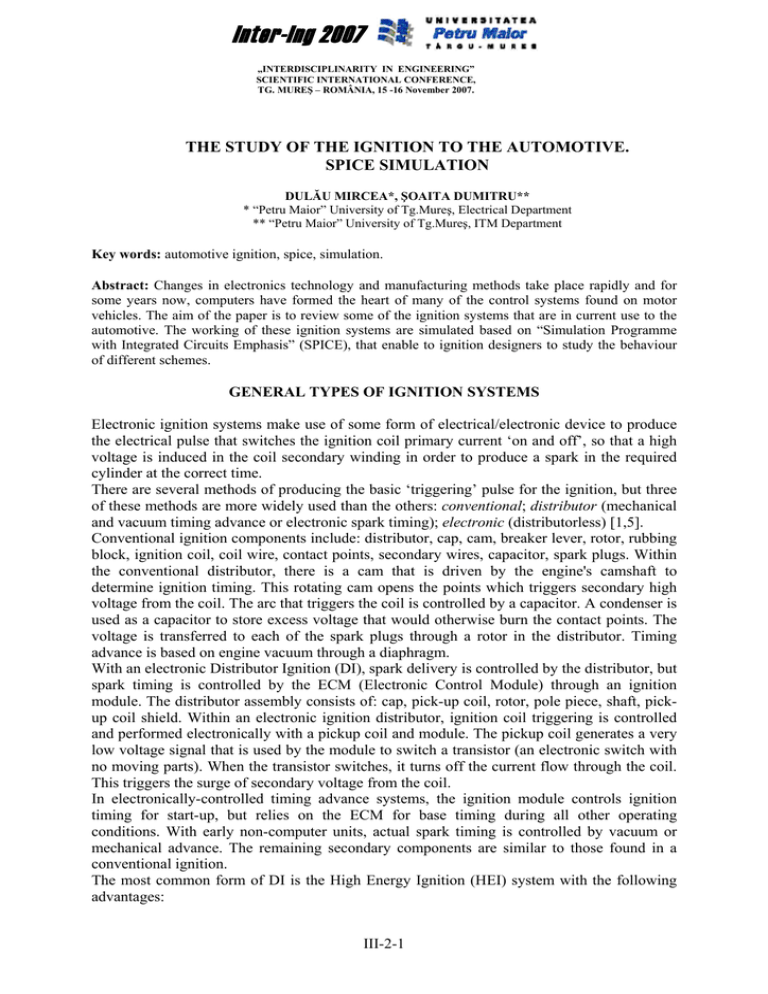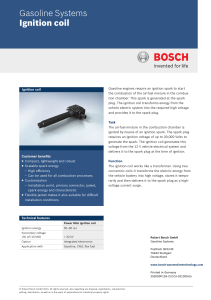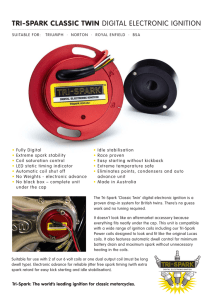Inter-Ing 2007 - Universitatea"Petru Maior"
advertisement

Inter-Ing 2007 „INTERDISCIPLINARITY IN ENGINEERING” SCIENTIFIC INTERNATIONAL CONFERENCE, TG. MUREŞ – ROMÂNIA, 15 -16 November 2007. THE STUDY OF THE IGNITION TO THE AUTOMOTIVE. SPICE SIMULATION DULĂU MIRCEA*, ŞOAITA DUMITRU** * “Petru Maior” University of Tg.Mureş, Electrical Department ** “Petru Maior” University of Tg.Mureş, ITM Department Key words: automotive ignition, spice, simulation. Abstract: Changes in electronics technology and manufacturing methods take place rapidly and for some years now, computers have formed the heart of many of the control systems found on motor vehicles. The aim of the paper is to review some of the ignition systems that are in current use to the automotive. The working of these ignition systems are simulated based on “Simulation Programme with Integrated Circuits Emphasis” (SPICE), that enable to ignition designers to study the behaviour of different schemes. GENERAL TYPES OF IGNITION SYSTEMS Electronic ignition systems make use of some form of electrical/electronic device to produce the electrical pulse that switches the ignition coil primary current ‘on and off’, so that a high voltage is induced in the coil secondary winding in order to produce a spark in the required cylinder at the correct time. There are several methods of producing the basic ‘triggering’ pulse for the ignition, but three of these methods are more widely used than the others: conventional; distributor (mechanical and vacuum timing advance or electronic spark timing); electronic (distributorless) [1,5]. Conventional ignition components include: distributor, cap, cam, breaker lever, rotor, rubbing block, ignition coil, coil wire, contact points, secondary wires, capacitor, spark plugs. Within the conventional distributor, there is a cam that is driven by the engine's camshaft to determine ignition timing. This rotating cam opens the points which triggers secondary high voltage from the coil. The arc that triggers the coil is controlled by a capacitor. A condenser is used as a capacitor to store excess voltage that would otherwise burn the contact points. The voltage is transferred to each of the spark plugs through a rotor in the distributor. Timing advance is based on engine vacuum through a diaphragm. With an electronic Distributor Ignition (DI), spark delivery is controlled by the distributor, but spark timing is controlled by the ECM (Electronic Control Module) through an ignition module. The distributor assembly consists of: cap, pick-up coil, rotor, pole piece, shaft, pickup coil shield. Within an electronic ignition distributor, ignition coil triggering is controlled and performed electronically with a pickup coil and module. The pickup coil generates a very low voltage signal that is used by the module to switch a transistor (an electronic switch with no moving parts). When the transistor switches, it turns off the current flow through the coil. This triggers the surge of secondary voltage from the coil. In electronically-controlled timing advance systems, the ignition module controls ignition timing for start-up, but relies on the ECM for base timing during all other operating conditions. With early non-computer units, actual spark timing is controlled by vacuum or mechanical advance. The remaining secondary components are similar to those found in a conventional ignition. The most common form of DI is the High Energy Ignition (HEI) system with the following advantages: III-2-1 ability to fire leaner mixtures with high voltages; extended spark plug life; fewer moving parts with reduced service; precise ECM timing control; electronically-controlled coil primary current. The distributorless Electronic Ignition (EI) system does not use a distributor. Instead, the secondary ignition wires connect directly to the ignition coils (one coil for every two spark plugs). The ignition module is typically mounted to the coils. Secondary voltage is triggered based upon electronic logic using a crankshaft position sensor. Timing is controlled by the ECM. A typical EI system includes: ignition module, ignition coils, crankshaft sensor, camshaft sensor, crankshaft wheel. • • • • • SPICE SIMULATION OF THE IGNITION SYSTEMS The ignition system, working on classical (mechanical) principle is presented in Figure 1, and the simulation block diagram, without spark plug is presented in Figure 2 [3]. Fig.1 Classical ignition system Fig.2 The simulation block diagram, without spark plug III-2-2 The energy for spark is taken by battery (1). Primary wires (5) are connected to the battery through the contact points and the cam (7). The secondary wires (L2) of the coil produce a high voltage that, through the distributor (8), is applied to the spark plugs (9). For the engines with spark ignition is valid the relation: f = z⋅n 60 ⋅ m (1) where: z is the number of cylinders; n – engine rotation [rot/min]; m – transmission rate; f – spark frequency. The frequency of 250 Hz, with fill factor of 1/2, corresponds for the engine with four cylinders and 1/1 transmission rate and 3750 rot/min. The programmes for analyse and simulation of the electronic circuits, use the Spice standard and allow the studies for direct current, time and/or frequency behaviours, graphical display of different waveforms, etc. Based on Micro-Cap Software, the breaker lever is simulated with a voltage controlled switch (V2-S), that generate impulses with fill factor, chosen by the user [4]. When the spark plug is missing, the secondary induction voltage has the amortised sinusoidal form, with the maximum of (25-30) kV, function of the engine rotation (Figure 3). Fig.3 The voltage forms in (1) and (5) nodes, without spark plug The system produces, to the spark plug level, a spark of high voltage (10-15) kV, capable to ignition the mixture fuel-air at the correct time. The block diagram for the Spice simulation, in the presence of the spark plug is presented in Figure 4 and the forms for the voltages are presented in Figure 5. The waveforms in (6) and (8) nodes (switches command) are presented in Figure 6. The behaviour of the spark plug is simulated with two voltage control switches, series connected (V3-S2, V4-S3), that opens when the voltage in secondary wires has maximum value (t2 moment). To the (t3) moment, the first switch close, (the second switch is open), and to the t4 moment the second switch close. On the (t2, t3) zone, a capacitive discharge takes place, follow by an inductive discharge (t3, t4). III-2-3 Fig.4 The ignition block diagram in the presence of the spark plug Fig.5 The voltage forms in (2) and (5) nodes, with spark plug Fig.6 The waveforms for switches command The conventional ignition system has many problems, due to the great values of the current (5-10) A that destroys the contacts. To eliminate these inconvenient, the electronic propose III-2-4 different types of ignition schemes (Figure 7). The waveforms for voltages and currents to induction coil are presented in Figures 8 and 9. Fig.7 The block diagram for ignition system Fig.8 The voltage waveforms in (8) and (10) nodes, with spark plug Fig.9 The current waveforms through the induction coil, with spark plug III-2-5 The transistor Q1 is polarised through R1, R2 divisor and the diode D1 polarise the base of Q2 that work as current amplifier. The secondary wires voltage has minimum 18 kV value (node 10). The Q2 collector voltage is limited to approximately 360 V with D2 diode. The current value through Q2 and to coil is limited by Q3. CONCLUSIONS In the conventional ignition systems, due to the great values of the current, the contacts are destroyed. These change the dwell angle and the energy from primary wires decrease, the high voltage decrease and the energy for ignition is lower. The flame between contacts produces perturbation signals of radio frequency. The electronic schemes allow a better working of the engine to the lower temperatures and protect the contacts, due to the lower current (mA order). Without the contacts destroying, the fuel economy and the safety starting to the lower temperatures are some of the advantages of the electronic ignition systems. The Spice programmes allow verifying the correct working of the different types of electronic block diagrams and are no need to realise the real schemes. REFERENCES [1] Bonnick A.W.M., Automotive Computer Controlled Systems. Diagnostic tools and techniques, Butterworth-Heinemann Linacre House, Jordan Hill, Oxford OX2 8DP, 2001. [2] Dulău M., Geampană E., CAD în automatică, Lucrări de laborator, Universitatea „Petru Maior” Tg.Mureş, 2002. [3] Tudor M., Spice, Editura Teora, Bucureşti, 1996. [4] Thomson A., O’Brien T., Micro-Cap Evaluation 7.0.3.0., Demo version, Spectrum Software, 2001. [5] http://electronice.adbent.ro III-2-6




